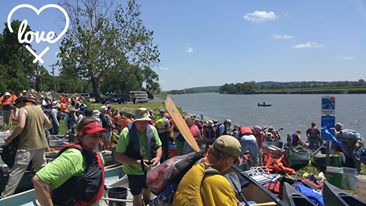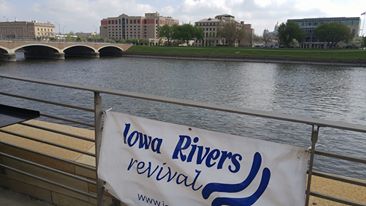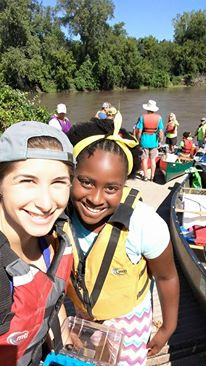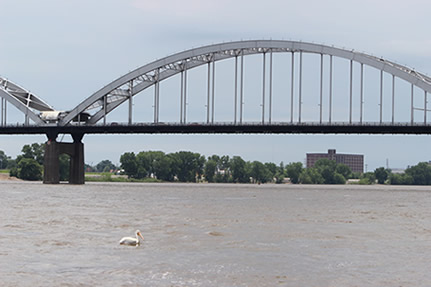Flanked by Two Great Rivers
posted
on Thursday, March 2, 2017
Flanked by two great rivers, with more than 70,000 miles of interior rivers and streams, Iowa’s rivers and their valleys hold much of Iowa’s remaining wilderness. Rivers provide many benefits and values for Iowa communities including water for everyday use, recreation, economic development and natural habitat for wildlife and quality of life opportunities. There are many threats that impact the condition and quality of our rivers including flooding, pollution (what you can and can’t see), erosion and general apathy for conservation priorities. Rivers are the barometer of the overall health of our ecosystem and Iowa Rivers Revival is working to ensure our rivers are safe, clean and enjoyable for future generations.
OUR MISSION: Helping Iowans protect, restore and enjoy Iowa’s rivers.
OUR VISION: Clean, free-flowing Iowa rivers teaming with life, surrounded by diverse landscapes and connecting vibrant communities.

One of our legislative priorities is to establish an Iowa River Restoration Program. Modeled after the successful Iowa Lake Restoration Program this program would provide funds, criteria, guidelines, training and expertise to begin watershed and priority-based natural river restoration in Iowa.
What is river restoration?
River restoration is a process of restoring rivers and streams to healthier, naturally-functioning ecosystems.
Why restore Iowa’s rivers?
Many sections of our rivers and streams have been degraded to the point where their natural functions are severely threatened. Many miles have been officially identified as impaired, with unstable, eroding banks and dwindling fish populations. Excessive amounts of sediment and nutrients cause algae blooms. The worst river segments are unhealthy, even dangerous, places for people, fish and wildlife.
Restored and healthy streams will:
-
Help Iowa meet nutrient pollution reduction goals. Stable, healthy streams, connected to adjacent vegetated (riparian) areas, can filter and remove nitrate and phosphorus (nutrients) in the river through natural processes. Unstable streams make the problem worse by releasing phosphorus and nitrogen locked up in riverbanks.
- Help landowners prevent loss of stream bank, land and infrastructure. Unstable stream banks contribute to flooding, cut away farm fields, and destroy river-crossing approaches.
- Help the state and counties address damage to bridges and roads. Excessive erosion undercuts bridge abutments and road surfaces and deposits silt on road beds.
- Reduce flooding and flood damage. Streams with stable, rounded banks, stable streambeds, two-stage channels and established native vegetation hold more water and slow down water.
- Cultivate a healthier ecosystem for fishing, hunting and wildlife. A healthy stream increases fish population and diversity and provides more habitat for aquatic life. A healthy greenbelt and river also provide essential habitat for a variety of native wildlife important to Iowans.


Increase and improve economic development. Rivers and streams are an integral factor in boosting local economies- they generate new business and jobs and create recreational opportunities to attract tourists. Spending on river recreation alone totals about $500 million per year in Iowa and supports almost 5,000 jobs. Hunting and fishing add millions more dollars.
River Restoration is required by US Federal law through the Clean Water Act, to compensate for road construction damage to rivers and streams. Iowa needs a restoration plan to set priorities for the best use of these funds and to provide guidance to road construction authorities. Currently, the Iowa Department of Natural Resources is working on a River Restoration Toolbox to accumulate, describe and advise on best practices.
How does river restoration work?
River restoration is complex and begins with analyzing the root causes of river disturbances. It is not “one size fits all.” The most successful projects draw on expertise from the fields of engineering, hydrology, landscape ecology, fisheries and plant science. To be successful, projects must engage communities, policy-makers and landowners.
River restoration can include such practices as:
- Stabilizing stream banks includes rebuilding and strengthening the stream bank using natural and native vegetation to help retain soil, reduce nitrate and phosphorus loss and slow the velocity of water.
- Re-meandering streams that have been straightened to a more natural winding course across the floodplain. Restoring natural curves in the river reduces the power of the river, increases storage capacity and slows the water to reduce flooding and sediment loss.
- Modifying or removing old or unneeded dams to ensure safe recreation and enhanced fish passage.
- Improving habitat by reintroducing native vegetation to help slow stream flow, reduce erosion and improve water quality, providing a healthy, diverse environment for people, fish and wildlife.
- Reshaping stream banks to establish a gradual slope or widen the channel base to improve drainage, provide greater storage capacity for water after heavy rains and enhance ecological functions such as nutrient filtration.
- Assessing the potential for river restoration and determining the preferred course of action.
How is river restoration different from watershed improvement?
A watershed is the landscape from which water flows into a stream or river. Watershed improvements are intended to provide cleaner water to streams and lakes and sometimes can also reduce the speed of water moving to streams. Watershed improvement projects are very important to reducing nutrients, sediment and bacteria going into rivers, but they do not adequately address existing in-stream problems of habitat loss and unstable stream banks and beds. River restoration should be viewed as complimentary to watershed work. Ideally, watershed practices should work together with river restoration to create balanced and healthy stream ecosystems.

A River Restoration Program for Iowa should:
- Rely on partnerships among public agencies, landowners, river users and the public.
- Incorporate up-to-date science to establish river and stream restoration priorities and statewide design standards for implementing practices.
- Provide education and training to assist landowners, engineers, contractors, communities and government agencies conducting river-related projects throughout Iowa.
- Set criteria and priorities for mitigation dollars (funds already being spent as part of federal regulatory requirements).
- Monitor the performance of projects and support research to improve restoration tools and improve effectiveness.
For more information, visit www.iowarivers.org
Or contact Molly Hanson, Executive Director
Iowa Rivers Revival
P.O. Box 72
Des Moines, Iowa 50301
515.309.3231
Written by Molly Hanson of Iowa Rivers Revival,
- meet our members
- water quality